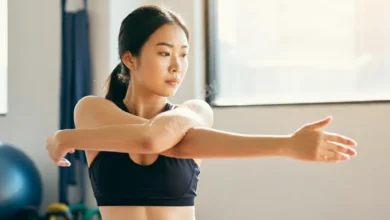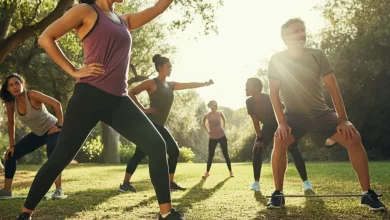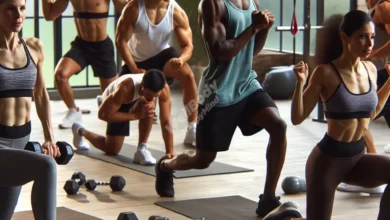How Do Fitness Routines Differ Across Cultures?

When it comes to fitness routines, different cultures around the world have unique approaches and practices that reflect their traditions, values, and lifestyles. Understanding these cultural differences not only broadens our perspective on fitness but also highlights the diversity of ways in which people stay active and healthy. From ancient practices rooted in tradition to modern trends influenced by globalization, exploring the varied fitness routines across cultures can offer valuable insights into the ways we approach physical well-being. Let’s delve into the fascinating world of fitness diversity across different cultures.
1. Traditional Asian Practices
In many Asian cultures, traditional practices like yoga, Tai Chi, and martial arts play a significant role in maintaining physical fitness and overall well-being. These disciplines emphasize mind-body connection, flexibility, balance, and strength. For example, yoga originated in ancient India and has gained popularity worldwide for its holistic approach to fitness and relaxation. Tai Chi, a Chinese martial art, focuses on slow, flowing movements that promote relaxation, stress reduction, and improved posture. Martial arts such as Kung Fu and Karate not only provide physical exercise but also instill discipline and mental focus.
2. High-Intensity Workouts in Western Societies
In contrast to the slow and deliberate movements of traditional Asian practices, many Western cultures gravitate towards high-intensity workouts like CrossFit, boot camps, and high-intensity interval training (HIIT). These workouts are known for their intensity, incorporating a mix of cardio, strength training, and functional movements. CrossFit, for instance, emphasizes varied, high-intensity workouts that challenge participants both physically and mentally. Boot camps often involve group training sessions that combine cardio and strength exercises for a full-body workout. HIIT workouts are characterized by short bursts of intense activity followed by brief rest periods, maximizing calorie burn and cardiovascular benefits.
3. Comparison of Fitness Routines Across Cultures
| Aspect | Asian Cultures | Western Societies |
|---|---|---|
| Emphasis | Mind-body connection, flexibility, balance, strength | High-intensity, cardio, strength, functional movements |
| Tradition | Rooted in ancient practices like yoga, Tai Chi, martial arts | Embracing modern trends like CrossFit, boot camps, HIIT |
| Philosophy | Focus on holistic well-being and mental clarity | Emphasis on physical performance and results |
4. Key Differences in Nutrition and Dietary Practices
- Asian cultures often emphasize balance and harmony in meals, incorporating a variety of vegetables, whole grains, and lean proteins.
- Western societies may prioritize convenience and quick meals, leading to higher consumption of processed foods and fast food.
5. Influence of Cultural Values on Fitness
Cultural values can significantly impact fitness routines. For example:
– Collectivist cultures may favor group fitness activities that promote social bonding and unity.
– Individualistic cultures may emphasize personal achievement and competition in fitness pursuits.
6. Role of Technology in Fitness Across Cultures
Technological advancements have influenced fitness practices globally:
– Fitness apps and wearable devices are popular in Western societies for tracking progress and setting goals.
– Virtual fitness classes and online coaching have made fitness more accessible to individuals in various cultures.
7. Climate and Geography Considerations
- Cultures in warmer climates may engage in outdoor activities like swimming, hiking, or beach sports.
- Cultures in colder regions may prefer indoor activities like gym workouts, indoor cycling, or winter sports.
8. Cultural Celebrations and Fitness Traditions
Many cultures incorporate fitness elements into their celebrations and traditions:
– Festivals with dance performances or processions that involve physical activity.
– Rituals or ceremonies that include physical challenges or feats of strength.
9. Body Image and Beauty Standards
- Cultural norms regarding body image and beauty ideals can influence fitness goals and practices.
- Some cultures may prioritize strength and athleticism, while others may emphasize slimness or specific physical attributes.
10. Adapting and Appreciating Cultural Diversity in Fitness
Embracing the diversity of fitness routines across cultures can enrich our own fitness journey:
– Exploring different fitness practices can offer new challenges and perspectives.
– Appreciating cultural traditions in fitness fosters respect and understanding for diverse approaches to well-being.
FAQ
Q: Are there any universal principles that apply to fitness regardless of culture?
A: While fitness practices vary across cultures, principles like consistency, proper form, and progressive overload are fundamental to achieving fitness goals.
Q: How can I incorporate elements of different cultural fitness routines into my own regimen?
A: You can try integrating aspects of various practices, such as yoga poses for flexibility or high-intensity intervals for cardio, to create a well-rounded fitness routine.
Key Takeaways
- Fitness routines vary across cultures, reflecting traditions, values, and lifestyles.
- Traditional Asian practices emphasize mind-body connection and balance, while Western societies lean towards high-intensity workouts.
- Cultural values, technology, climate, and body image influence how fitness is approached globally.
- Embracing cultural diversity in fitness can enhance our understanding and appreciation of different approaches to well-being.



